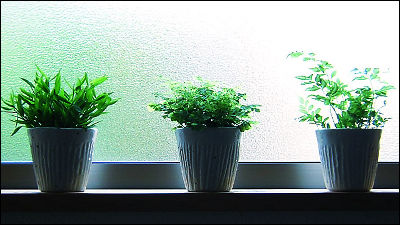How to choose foliage plants that clean the air in the office

By
It is said that foliage plants clean the air, but what is the best foliage plant to put in the office? It is said that 'if you have this, you can live even if you are trapped in a sealed bottle' 3 Kind of plants have been released.
How to make delicious air yourself by Kamal Mettle | Video on TED.com
http://www.ted.com/talks/lang/ja/kamal_meattle_on_how_to_grow_your_own_fresh_air.html
The movie is from the following.
Here is Mr. Kamal Mettle who announced the three kinds of foliage plants.

Areca palm is the first plant that keeps the air clean when placed in the office without ventilation.

Areca palm removes carbon dioxide and replaces it with oxygen.
CHRYSALIDOCARPUS LUTESCENS Potted plant-IKEA (2290 yen)

Each person needs four shoulder-high plants to clean the air. In Delhi, you have to wipe the leaves every day, but if the air is clean, you can wipe the leaves once a week. It must be grown in fertilizer called bemi (solid oil cake) or hydroponically grown and taken out every three to four months.

The second is Sansevieria Trifasciata (Japanese name: Atsubachitoceran ).

Atsubachitoceran is a popular foliage plant, also known as a 'bedroom plant', because it converts carbon dioxide into oxygen at night. Each person needs 6 to 8 plants that are about the height of the waist.
Sansberia Trifasciata Wave Square Pottery Pot: Online shopping for foliage plants MAKIMO PLANT (6000 yen)

The last is Potos .

This is a ubiquitous plant and is recommended to be grown hydroponically. Potos removes highly volatile chemicals such as formaldehyde.
Amazon.co.jp: Potos (Ougon Kazura) Tower Tailored Nakabachi (No. 8): Home & Kitchen (6000 yen)

These three types of plants produce the amount of outside air we need.

We prepared about 1,200 plants of these plants for about 300 residents and raised them in a 20-year-old 4,600-square-meter building in Delhi. It means that there is a 1% chance that the amount of oxygen in the blood has increased by 1%. In addition, compared to other buildings, cases of eye irritation were reduced by 52%, respiratory disorders by 34%, headaches by 24%, lung dysfunction by 12%, and asthma by 9%. There was a decrease. In addition, the use of these plants will increase human production capacity by as much as 20%.

In addition, since the supply of outside air is small, the amount of heat used to maintain the building can be reduced by as much as 15%. Currently, 40% of the world's energy is consumed in buildings, and it is said that in the next 15 years 60% of the world's population will live in air-conditioned buildings in cities with a population of over 1 million. Therefore, it is predicted that the amount of energy required by the world will increase by 30% in the next 10 years. These three types of plants should be useful in such an environment.

By Gulfu
Mr. Kamal Mettle has started studying foliage plants after being told by a doctor that his lung capacity has dropped to 70% due to allergies and that his life is dangerous if nothing is done. The research will be further expanded afterwards, and 60,000 plants will be placed indoors in a building of about 160,000 square meters for testing.
Related Posts:







